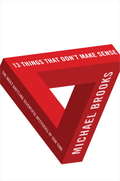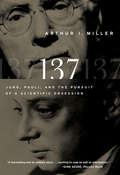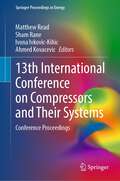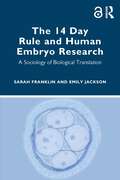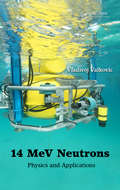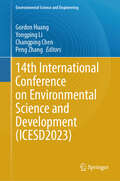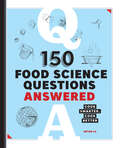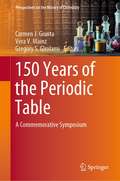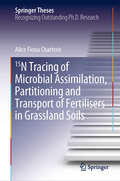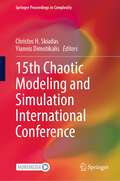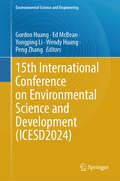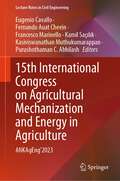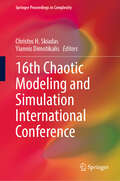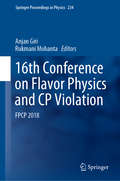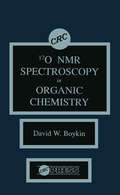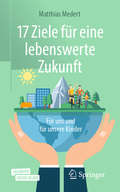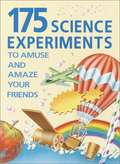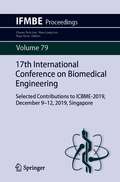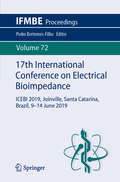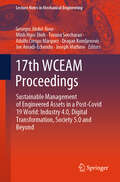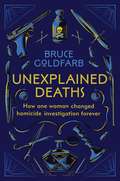- Table View
- List View
13 Things That Don't Make Sense: The Most Baffling Scientific Mysteries of Our Time
by Michael BrooksJournalist Brooks reviews the 13 anomalies scientists love most, reaching into the secrets of physics, biology and psychology. He examines why the Pioneer space project goes on, why the universe is unstable, why cold fusion works, whether living beings are more than just bags of chemicals with options, why Mars may or may not have life (depending on the day and the scientist), whether the aliens have landed, how a giant virus started it all, why free will is a farce, who deceives whom in the placebo effect, and why alternative medicine works when it makes no sense to the scientific mind, which, of course, finds more fun with the odd than the proven. Annotation ©2008 Book News, Inc. , Portland, OR (booknews. com)
13 Ways to Eat a Fly
by Sue HeavenrichThirteen flies become tasty snacks in this clever reverse counting book about subtraction, predators, and prey.Science meets subtraction in this fresh and funny STEM picture book with plenty of ewww factor to please young readers. A swarm of thirteen flies buzzes along, losing one member to each predator along the way. Whether the unfortunate insects are zapped or wrapped, liquefied or zombified, the science is real--and hilariously gross. Includes a guide to eating bugs, complete with nutritional information for a single serving of flies.
137: Jung, Pauli, and the Pursuit of a Scientific Obsession
by Arthur I. Miller"The history is fascinating, as are the insights into the personalities of these great thinkers."--New Scientist Is there a number at the root of the universe? A primal number that everything in the world hinges on? This question exercised many great minds of the twentieth century, among them the groundbreaking physicist Wolfgang Pauli and the famous psychoanalyst Carl Jung. Their obsession with the power of certain numbers--including 137, which describes the atom's fine-structure constant and has great Kabbalistic significance--led them to develop an unlikely friendship and to embark on a joint mystical quest reaching deep into medieval alchemy, dream interpretation, and the Chinese Book of Changes. 137 explores the profound intersection of modern science with the occult, but above all it is the tale of an extraordinary, fruitful friendship between two of the greatest thinkers of our times. Originally published in hardcover as Deciphering the Cosmic Number.
13th International Conference on Compressors and Their Systems: Conference Proceedings (Springer Proceedings in Energy)
by Matthew Read Sham Rane Ivona Ivkovic-Kihic Ahmed KovacevicThis new proceedings discusses developments in air, gas and refrigeration compressors, vacuum pumps, and expanders. It is the 13th edition of the International Conference on Compressors and their Systems, a three-day conference organised by the Centre for Compressors Technology at City, University of London in collaboration with, among other, the MEchE, IIR, and IOR.The conference offers a platform to identify current challenges in the field and provide the essential content and direction to shape future research. The International Conference on Compressors and their Systems series began in 1999 as a result of industrial consultation and a need for academic collaboration. Initially, the conference was organised by the Fluid Machinery Group of the Institution of Mechanical Engineers (IMechE) with the support of Holroyd. From 2009, the Centre for Compressor Technology at City, University of London took over its management and the conference is now one of the main conventions, taking place biennially in the UK, becoming world-renowned for its place in industry and academia to gather and discuss a broad range of topical issues related to compressors and compression systems.This year's conference has the theme "Compressors and Expanders in Future Energy Systems” and will be of interest to researchers and engineers in industry.
The 14 Day Rule and Human Embryo Research: A Sociology of Biological Translation
by Sarah Franklin Emily JacksonThis assessment of Britain’s influential 14 day rule governing embryo research explores how and why it became the de facto global standard for research into human fertilisation and embryology, arguing that its influence and stability offers valuable lessons for successful biological translation.One of the most important features of the 14 day rule, the authors claim, is its reliance on sociological as well as ethical, legislative, regulatory and scientific principles. The careful integration of social expectations and perceptions, as well as sociological definitions of the law and morality, into the development of a robust legislative infrastructure of ‘human fertilisation and embryology’, enabled what has come to be known as the Warnock Consensus – a solid and enduring public acceptance that has enabled successive parliamentary approval for controversial areas of scientific research in the UK, such as stem cell research and mitochondrial donation, for over 30 years. These important sociological insights are increasingly relevant to new biotranslational challenges such as human germline gene editing and the use of AI assisted technologies in human reproduction. As the legislation around the 14 day rule begins to be reviewed worldwide, the important lessons we can learn from its global and enduring significance will apply not only to future legislation governing embryo research, but to the future of biological translation more widely.An important volume for those interested in reproductive studies, biogovernance and biological translation, it is suitable for researchers, clinicians and students in medicine, biosciences, sociology, and science and technology studies.
14 MeV Neutrons: Physics and Applications
by Vladivoj ValkovicDespite the often difficult and time-consuming effort of performing experiments with fast (14 MeV) neutrons, these neutrons can offer special insight into nucleus and other materials because of the absence of charge. 14 MeV Neutrons: Physics and Applications explores fast neutrons in basic science and applications to problems in medicine, the envir
14th International Conference on Environmental Science and Development (Environmental Science and Engineering)
by Gordon Huang Yongping Li Changping Chen Peng ZhangThis book is proposed to be a collection of excellently peer-reviewed research from the 2023 14th International Conference on Environmental Science and Development (ICESD 2023), which will be held during May 25-27, 2023, in Xiamen, China. ICESD 2023 will gather innovative academics and industrial experts to a common forum to facilitate the exchange of scientific information and its application in the field of Environmental Science and Sustainable Development. Particularly, a large amount of the research is related to the Water Governance Programme which is an initiative as developed by the China International Center for Economic and Technical Exchanges, United Nations Development Programme, and Coca-Cola China. Recently, effects of energy crisis, water scarcity, environmental pollution, climate change, COVID-19 pandemic, and their interactions on eco-environment and health have caused extraordinary risks in socio-economic and environmental systems (SEE). Such risks feature dynamic, uncertain, and interactive characteristics. In order to tackle these risks, cutting-edge technologies, including both experimental approaches and modeling ones, are desired urgently. Particularly, nature-based solutions will be developed to help achieve net-zero emission and United Nations Sustainable Development Goals. In addition, data-driven and AI-based methodologies will be developed to facilitate policy analysis of SEE under New Normal scenarios. Furthermore, the combinations of multiple approaches are expected to support the enhancement of SEE resilience in a post-pandemic future. Consequently, ICESD 2023 will include presentations in the field of Water Resources Management, Wastewater Treatment, Drinking Water Safety, Energy and Environmental Systems Analysis, Air Pollution Control, Solid Waste Management, Sustainable Development, Ecosystem Restoration, Climate Change Adaptation, and Socio-economic and Environmental Management. Excellent papers related to these topics would be enclosed in this proposed book.
150 Food Science Questions Answered: Cook Smarter, Cook Better
by Bryan LeCooking isn't just an art, it's a science—150 fascinating food facts to make you a better cook Does cold water come to a boil faster than warm water? Why does fat taste so good? What makes popcorn pop? Most of the processes that occur during cooking are based on principles found in biology, chemistry, and physics. 150 Food Science Questions Answered is an intriguing look into the science of food, from the eyes of a food science Ph.D. candidate and recipient of the James Beard Legacy Scholarship. Learn food science—how controlling heat, moisture, acidity, and salt content can magically transform the way flavors are developed and perceived. Understand the food science behind the few hundred milliseconds that creates our sense of taste. With increased knowledge will come increased mastery, no matter what you're cooking. Inside 150 Food Science Questions Answered you'll find: Can you control garlic's intensity by the way you cut it?—Garlic's signature burn is released when its cell walls are cut into. Whole garlic will impart mild flavor; garlic crushed into a paste will deliver the strongest punch. Does alcohol burn off when cooked?—Quick processes like flambé eliminate only about 25% of alcohol, while long-simmering can remove almost all of it. Does searing a steak seal in the juices?—No, but it does develop delicious flavors through a process called the Maillard reaction. Learn food science and you'll be on your way to truly understanding the chemistry of cooking.
150 Years of the Periodic Table: A Commemorative Symposium (Perspectives on the History of Chemistry)
by Carmen J. Giunta Vera V. Mainz Gregory S. GirolamiThis book provides an overview of the origins and evolution of the periodic system from its prehistory to the latest synthetic elements and possible future additions. The periodic system of the elements first emerged as a comprehensive classificatory and predictive tool for chemistry during the 1860s. Its subsequent embodiment in various versions has made it one of the most recognizable icons of science. Based primarily on a symposium titled “150 Years of the Periodic Table” and held at the August 2019 national meeting of the American Chemical Society, this book describes the origins of the periodic law, developments that led to its acceptance, chemical families that the system struggled to accommodate, extension of the periodic system to include synthetic elements, and various cultural aspects of the system that were celebrated during the International Year of the Periodic Table.
15N Tracing of Microbial Assimilation, Partitioning and Transport of Fertilisers in Grassland Soils (Springer Theses)
by Alice Fiona CharterisThis book presents innovative research on soil nitrogen cycling and nitrate leaching with a view to improving soil management and fertiliser nitrogen use efficiency and reducing nitrogen leaching losses. In this regard, nitrogen-15 (15N)-labelled fertiliser was used as a biochemical and physical stable isotope tracer in laboratory and field experiments. The major outcome of the research was the development, validation and application of a new compound-specific amino acid 15N stable isotope probing method for assessing the assimilation of fertiliser nitrogen by soil microbial biomass. The novelty of the method lies in its tracing of incorporated nitrogen into newly biosynthesised microbial protein in time-course experiments using gas chromatography-combustion-isotope ratio mass spectrometry. The approach provides previously unattainable insights into the microbial processing of different nitrogen fertilisers in different soils. Further, it identifies the mechanistic link between molecular-scale processes and observations of field-scale fertiliser nitrogen immobilisation studies. The method and the results presented here will have far-reaching implications for the development of enhanced recommendations concerning farm-based soil management practices for increasing soil productivity and reducing nitrogen losses, which is essential to minimising environmental impacts.
15th Chaotic Modeling and Simulation International Conference (Springer Proceedings in Complexity)
by Christos H. Skiadas Yiannis DimotikalisThis proceedings of 15th CHAOS2022 International Conference highlights recent developments in nonlinear, dynamical, and complex systems. The conference was intended to provide an essential forum for Scientists and Engineers to exchange ideas, methods, and techniques in the field of Nonlinear Dynamics, Chaos, Fractals and their applications in General Science and Engineering Sciences. The principal aim of CHAOS2022 International Conference is to expand the development of the theories of the applied nonlinear field, the methods, empirical data and computer techniques as well as the best theoretical achievements of chaotic theory. CHAOS2022 Conference provides a forum for bringing together the various groups working in the area of Nonlinear and Dynamical Systems, Chaotic theory and Application to exchange views and report research findings.
15th International Conference on Environmental Science and Development (Environmental Science and Engineering)
by Gordon Huang Ed McBean Yongping Li Wendy Huang Peng ZhangThis book is proposed to be a collection of excellently peer-reviewed research from the 2024 15th International Conference on Environmental Science and Development (ICESD 2024), which will be held during August 7-9, 2024 in Calgary, Canada. ICESD 2024 will gather innovative academics and industrial experts to a common forum to facilitate the exchange of scientific information and its application in the field of Environmental Science and Sustainable Development. Particularly, a large amount of the research is related to the Water Governance Programme which is an initiative as developed by the China International Center for Economic and Technical Exchanges, United Nations Development Programme, and Coca- Cola China. Recently, effects of energy crisis, water scarcity, environmental pollution, climate change, pandemic, and their interactions on eco-environment and health have caused extraordinary risks in socio-economic and environmental systems (SEE). Such risks feature dynamic, uncertain and interactive characteristics. In order to tackle these risks, cutting-edge technologies, including both experimental approaches and modeling ones, are desired urgently. Particularly, nature-based solutions will be developed to help achieve net-zero emission and United Nations Sustainable Development Goals. In addition, data-driven and AI-based methodologies will be developed to facilitate policy analysis of SEE under New Normal scenarios. Furthermore, the combinations of multiple approaches are expected to support the enhancement of SEE resilience in a post- pandemic future. Consequently, ICESD 2024 will include presentations in the field of Water Resources Management, Wastewater Treatment, Drinking Water Safety, Energy and Environmental systems Analysis, Air Pollution Control, Solid Waste Management, Sustainable Development, Ecosystem Restoration, Climate change adaptation, and Socio-Economic and Environmental Management. Excellent papers related to these topics would be enclosed in this proposed book.
15th International Congress on Agricultural Mechanization and Energy in Agriculture: ANKAgEng’2023 (Lecture Notes in Civil Engineering #458)
by Eugenio Cavallo Fernando Auat Cheein Francesco Marinello Kamil Saçılık Kasiviswanathan Muthukumarappan Purushothaman C. AbhilashThis volume highlights the latest advances, innovations, and applications in the field of agricultural technologies engineering, as presented by leading international researchers and engineers at the 15th International Congress on Agricultural Mechanization and Energy in Agriculture (ANKAgEng), held in Antalya, Turkey on October 29 – November 1, 2022. It covers a diverse range of topics such as machinery and energy systems, agriculture information technologies, digital-smart agriculture, ergonomics, health & safety, system engineering, post-harvest technologies & process engineering, sustainable agriculture, natural resources & environmental systems, plant, animal & facility systems, agricultural engineering education and biosystems engineering. The contributions, which were selected by means of a rigorous international peer-review process, present a wealth of exciting ideas that will open novel research directions and foster multidisciplinary collaboration among different specialists.
16th Chaotic Modeling and Simulation International Conference (Springer Proceedings in Complexity)
by Christos H. Skiadas Yiannis DimotikalisThis proceedings of 16th CHAOS2023 International Conference highlights recent developments in nonlinear, dynamical, and complex systems. The conference was intended to provide an essential forum for Scientists and Engineers to exchange ideas, methods, and techniques in the field of Nonlinear Dynamics, Chaos, Fractals, and their applications in General Science and Engineering Sciences. The principal aim of CHAOS2023 International Conference is to expand the development of the theories of the applied nonlinear field, the methods, empirical data, and computer techniques as well as the best theoretical achievements of chaotic theory. CHAOS2023 Conference provides a forum for bringing together the various groups working in the area of Nonlinear and Dynamical Systems, Chaotic theory, and Application to exchange views and report research findings. Chapter 22 and 23 are available open access under a Creative Commons Attribution 4.0 International License via link.springer.com.
16th Conference on Flavor Physics and CP Violation: FPCP 2018 (Springer Proceedings in Physics #234)
by Anjan Giri Rukmani MohantaPresenting the proceedings of FPCP 2018, this book reviews the status quo of flavor physics and discusses the latest findings in this exciting area. Flavor physics has been instrumental in the formulation and understanding of the standard model, and it is possible that the direction of new physics will be significantly influenced by flavor sector, also known as the intensity frontier, making it possible to indirectly test the existence of new physics up to a very high scale, beyond that of the energy frontier scale accessible at the LHC.The book is intended for academics around the globe involved in particle physics research, professionals associated with the related technologies and those who are interested in learning about the future of physics and its prospects and directions.
17 0 NMR Spectroscopy in Organic Chemistry
by David W. BoykinThis book provides a comprehensive review of the application of 17O NMR spectroscopy to organic chemistry. Topics include the theoretical aspects of chemical shift, quadrupolar and J coupling; 17O enrichment; the effect of steric interactions on 17O chemical shifts of functional groups in flexible and rigid systems; the application of 17O NMR spectroscopy to hydrogen bonding investigations; mechanistic problems in organic and bioorganic chemistry; and 17O NMR spectroscopy of oxygen monocoordinated to carbon in alcohols, ethers, and derivatives. Recent results that show correlations between molecular geometry, determined by X-ray studies and estimated by molecular mechanics calculations, and 17O chemical shifts are also covered. 17O Spectroscopy in Organic Chemistry provides important reference information for organic chemists and other scientists interested in 17O NMR spectroscopy as a tool for obtaining new structural and chemical data about organic molecules.
17 Ziele für eine lebenswerte Zukunft: Für uns und für unsere Kinder
by Matthias MedertVielleicht machst auch du dir Sorgen darüber, wohin die vielen ökologischen und sozialen Probleme führen werden, von welcher Art und Ausmaß die Konsequenzen sein können und wie diese das Leben von Menschen betreffen werden? Dann könnte dieses Buch interessant für Dich sein: Es beschreibt anhand der 17 UN-Nachhaltigkeitsziele eine Vision für eine lebenswerte Zukunft. Du erfährst kurz und verständlich zu jedem der Ziele konkrete Hintergründe, Zusammenhänge und Herausforderungen, die es auf dem Weg dorthin noch zu meistern gilt. Es macht die Themen greifbar - sowohl global als auch bezogen auf Deutschland. Gleichzeitig liefert Dir das Buch Anregungen, wie Du selbst dazu beitragen kannst, die großen Probleme der Menschheit zu lösen: Klimawandel, Energie, Plastikmüll, Artenvielfalt, Umweltschutz, Hunger, Armut, etc.Zusammen können wir es schaffen, die 17 Ziele umzusetzen, indem wir sie mit konkreten Inhalten füllen. Falls uns das gelingt fragen unsere Kinder vielleicht eines Tages: „Wie habt ihr damals die Erde gerettet und die Menschheit in das Zeitalter der sozialen Gerechtigkeit geführt?“
175 Science Experiments to Amuse and Amaze Your Friends: Experiments, Tricks, Things to Make
by Brenda Walpole"Facts, experiments, tricks based on scientific principles, and things to make comprise the text of this book. The material is divided into four sections--water, air, movement, and light. The language used is clear, concise, and interesting. Every experiment, trick, and object to make is not only explained clearly but illustrated as well, making the book especially useful for the visual learner. There is so much here to intrigue readers! This will surely bring young readers into the interesting world of science." --(starred)Science Books & Films.
17th International Conference on Biomedical Engineering: Selected Contributions to ICBME-2019, December 9–12, 2019, Singapore (IFMBE Proceedings #79)
by Chwee Teck Lim Hwa Liang Leo Raye YeowThis book gathers contributions presented at the 17th International Conference on Biomedical Engineering, held on December 9-12, 2019, in Singapore. It continues the tradition of the previous conference proceedings, thus reporting on both fundamental and applied research. It includes a set of carefully selected chapters reporting on new models and algorithms and their applications in medical diagnosis or therapy. It also discusses advances in tele-health and assistive technologies, as well as applications of nanotechnologies. Organized jointly by the Department of Biomedical Engineering of the National University of Singapore and the Biomedical Engineering Society (Singapore), this book offers a timely snapshot of innovative research and technologies and a source of inspiration for future developments and collaborations in the field of biomedical engineering.
17th International Conference on Electrical Bioimpedance: ICEBI 2019, Joinville, Santa Catarina, Brazil, 9-14 June 2019 (IFMBE Proceedings #72)
by Pedro Bertemes-FilhoThis book gathers the proceedings of the 17th International Conference on Electrical Bioimpedance (ICEBI 2019), held on June 9-14, in Joinville, Santa Catarina, Brazil. The chapters cover the latest knowledge and developments concerning: sensors and instrumentation to measure bioimpendance, bioimpedance imaging techniques, theory and modeling and bioimpendance, as well as cutting-edge clinical applications of bioimpendance. All in all, this book provides graduate students and researchers with an extensive and timely snapshot of current research and challenges in the field of electrical bioimpendance, and a source of inspiration for future research and cross-disciplinary collaborations.
17th WCEAM Proceedings: Sustainable Management of Engineered Assets in a Post-Covid 19 World: Industry 4.0, Digital Transformation, Society 5.0 and Beyond (Lecture Notes in Mechanical Engineering)
by Georges Abdul-Nour Minh Ngoc Dinh Turuna Seecharan Adolfo Crespo Márquez Dragan Komljenovic Joe Amadi-Echendu Joseph Mathew17th WCEAM Proceedings provides a record of some of the intellectual discussions (including keynote addresses, research paper presentations, panel debates and practical workshops) that took place among the attendees and participants of the 17th World Congress on Engineering Asset Management (WCEAM), held from 18 - 20 October 2024 at the Sheraton Saigon Hotel and Towers, Ho Chi Minh City, Vietnam. The events were organized by the International Society for Engineering Asset Management (ISEAM) and hosted by RMIT University Vietnam LLC (RMIT VN), Ho Chi Ming City. The content of the book includes topics listed below under a general theme of Sustainable Management of Engineered Assets in a Post-Covid World: Industry 4.0, Digital Transformation, Society 5.0 and beyond Sustainable asset investment, acquisition, operations, maintenance, and retirement strategies Production-service transformation and product-service systems Sustainable asset acquisition, operations, maintenance, and retirement processes Modeling and simulation of acquisition, operations, maintenance, and retirement processes Reliability and resilience engineering Applications of the Fourth Industrial Revolution (4IR) technologies in EAM, e.g., Digital Twins Cybersecurity issues in asset management Asset condition, risk, resilience, and vulnerability assessments Asset management and decision support systems Applications of international and logical guidelines and standards in EAM Human dimensions and asset management performance Case studies of asset management in various industries and sectors This proceedings is an excellent resource for asset management practitioners, researchers and academics, as well as undergraduate and postgraduate students.
18 Tiny Deaths: The Untold Story of Frances Glessner Lee and the Invention of Modern Forensics
by Bruce GoldfarbFor most of human history, sudden and unexpected deaths of a suspicious nature, when they were investigated at all, were examined by lay persons without any formal training. People often got away with murder. Modern forensic investigation originates with Frances Glessner Lee - a pivotal figure in police science.'Disturbing dioramas created by an American millionairess revolutionised the art of modern forensics.' DAILY TELEGRAPH Frances Glessner Lee (1878-1962), born a socialite to a wealthy and influential Chicago family, was never meant to have a career, let alone one steeped in death and depravity. Yet she became the mother of modern forensics and was instrumental in elevating homicide investigation to a scientific discipline. Frances Glessner Lee learned forensic science under the tutelage of pioneering medical examiner Magrath - he told her about his cases, gave her access to the autopsy room to observe post-mortems and taught her about poisons and patterns of injury. A voracious reader too, Lee acquired and read books on criminology and forensic science - eventually establishing the largest library of legal medicine. Lee went on to create The Nutshell Studies of Unexplained Death - a series of dollhouse-sized crime scene dioramas depicting the facts of actual cases in exquisitely detailed miniature - and perhaps the thing she is most famous for. Celebrated by artists, miniaturists and scientists, the Nutshell Studies are a singularly unusual collection. They were first used as a teaching tool in homicide seminars at Harvard Medical School in the 1930s, and then in 1945 the homicide seminar for police detectives that is the longest-running and still the highest-regarded training of its kind in America. Both of which were established by the pioneering Lee.In 18 Tiny Deaths, Bruce Goldfarb weaves Lee's remarkable story with the advances in forensics made in her lifetime to tell the tale of the birth of modern forensics.
18 Tiny Deaths: The Untold Story of Frances Glessner Lee and the Invention of Modern Forensics
by Bruce Goldfarb"Eye-opening biography of Frances Glessner Lee, who brought American medical forensics into the scientific age...genuinely compelling."—Kirkus Reviews "A captivating portrait of a feminist hero and forensic pioneer." —BooklistThe story of a woman whose ambition and accomplishments far exceeded the expectations of her time, 18 Tiny Deaths follows the transformation of a young, wealthy socialite into the mother of modern forensics...Frances Glessner Lee, born a socialite to a wealthy and influential Chicago family in the 1870s, was never meant to have a career, let alone one steeped in death and depravity. Yet she developed a fascination with the investigation of violent crimes, and made it her life's work. Best known for creating the Nutshell Studies of Unexplained Death, a series of dollhouses that appear charming—until you notice the macabre little details: an overturned chair, or a blood-spattered comforter. And then, of course, there are the bodies—splayed out on the floor, draped over chairs—clothed in garments that Lee lovingly knit with sewing pins.18 Tiny Deaths, by official biographer Bruce Goldfarb, delves into Lee's journey from grandmother without a college degree to leading the scientific investigation of unexpected death out of the dark confines of centuries-old techniques and into the light of the modern day.Lee developed a system that used the Nutshells dioramas to train law enforcement officers to investigate violent crimes, and her methods are still used today.18 Tiny Deaths transports the reader back in time and tells the story of how one woman, who should never have even been allowed into the classrooms she ended up teaching in, changed the face of science forever.
180 Days of Science for Fourth Grade: Practice, Assess, Diagnose
by Lauren Homayoun180 Days of Science is a fun and effective daily practice workbook designed to help students explore the three strands of science: life, physical, and earth and space. <P><P>This easy-to-use fourth grade workbook is great for at-home learning or in the classroom. The engaging standards-based activities cover grade-level skills with easy to follow instructions and an answer key to quickly assess student understanding. Students will explore a new topic each week building content knowledge, analyzing data, developing questions, planning solutions, and communicating results. Watch as students are motivated to learn scientific practices with these quick independent learning activities. Parents appreciate the teacher-approved activity books that keep their child engaged and learning. Great for homeschooling, to reinforce learning at school, or prevent learning loss over summer. <P><P>Teachers rely on the daily practice workbooks to save them valuable time. The ready to implement activities are perfect for daily morning review or homework. The activities can also be used for intervention skill building to address learning gaps. Aligns to Next Generation Science Standards (NGSS).
180 Days of Science for Third Grade: Practice, Assess, Diagnose
by Shell Education Melissa Iwinski180 Days of Science is a fun and effective daily practice workbook designed to help students explore the three strands of science: life, physical, and earth and space. This easy-to-use third-grade workbook is great for at-home learning or in the classroom. The engaging standards-based activities cover grade-level skills with easy to follow instructions and an answer key to quickly assess student understanding. Students will explore a new topic each week building content knowledge, analyzing data, developing questions, planning solutions, and communicating results. Watch as students are motivated to learn scientific practices with these quick independent learning activities. Parents appreciate the teacher-approved activity books that keep their child engaged and learning. Great for homeschooling, to reinforce learning at school, or prevent learning loss over summer. Teachers rely on the daily practice workbooks to save them valuable time. The ready to implement activities are perfect for daily morning review or homework. The activities can also be used for intervention skill building to address learning gaps. Aligns to Next Generation Science Standards (NGSS).
